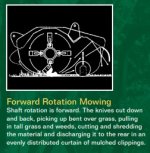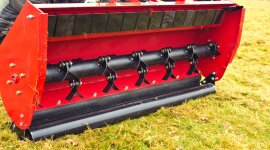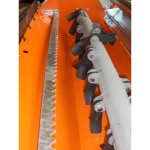Flail mower basics and knife rotation
I'd like to add some general observations regarding cutting tall grass and weeds with flail mowers. I've owned and used Seppi, Rears, Trimax, Alamo, and Befco, and all types of knives. I've had these flails on 3 point tractors and more sophisticated front mount machines as well. I've used flails with and without gauge wheels.
A lot has been said on this forum regarding flail knife rotation. By way of definition, forward rotation is rotating the same as the tractor wheels, backwards rotating is the opposite. Some brands of flails rotate forward, some backwards.
In my own experience, the backwards running flail knives give a poor cut on tall grass. The mower housing bends the grass over enough that unless the flail is set very low, the tall stuff doesn't get cut. They thoroughly mulch what they do cut, which uses a lot of horsepower.
Forward rotating flail knives give a much cleaner cut on grass, and can cut tall grass cleanly without using an undue amount of horsepower. On a rear mounted forward rotating flail, the grass is pushed over forwards by the tractor tires and the mower body, which puts it in the perfect position to be neatly up-cut by the rotating flails. The cut is clean, there are no tire tracks, and the grass is easily ejected from the mower, reducing the necessary horsepower. I use 50 HP on a 8 foot flail in tall grass. With the same 8 foot flail set up for reverse rotation, 100 HP wasn't always enough, and the cut was awful.
It took me years of using different makes of flails to figure out this simple principle. On some makes you can change rotation by moving a gear inside the gearbox. Better to buy a flail already set up for the rotation you want.
The other thing two things that effect cut are the knife tip speed (based on rpm and cutting circle diameter), and the mower housing height. The more room there is inside the mower housing, the easier it is for taller grass to stand up , get cut, and be smoothly ejected out the back.
These observations relate mostly to cutting grass and weeds with a flail. If you are using hammer flails to mulch tree branches, etc., your needs may be much different. In that case, a reverse rotation may be better for mulching wood into smaller pieces.
I hope these observations are helpful.
I'd like to add some general observations regarding cutting tall grass and weeds with flail mowers. I've owned and used Seppi, Rears, Trimax, Alamo, and Befco, and all types of knives. I've had these flails on 3 point tractors and more sophisticated front mount machines as well. I've used flails with and without gauge wheels.
A lot has been said on this forum regarding flail knife rotation. By way of definition, forward rotation is rotating the same as the tractor wheels, backwards rotating is the opposite. Some brands of flails rotate forward, some backwards.
In my own experience, the backwards running flail knives give a poor cut on tall grass. The mower housing bends the grass over enough that unless the flail is set very low, the tall stuff doesn't get cut. They thoroughly mulch what they do cut, which uses a lot of horsepower.
Forward rotating flail knives give a much cleaner cut on grass, and can cut tall grass cleanly without using an undue amount of horsepower. On a rear mounted forward rotating flail, the grass is pushed over forwards by the tractor tires and the mower body, which puts it in the perfect position to be neatly up-cut by the rotating flails. The cut is clean, there are no tire tracks, and the grass is easily ejected from the mower, reducing the necessary horsepower. I use 50 HP on a 8 foot flail in tall grass. With the same 8 foot flail set up for reverse rotation, 100 HP wasn't always enough, and the cut was awful.
It took me years of using different makes of flails to figure out this simple principle. On some makes you can change rotation by moving a gear inside the gearbox. Better to buy a flail already set up for the rotation you want.
The other thing two things that effect cut are the knife tip speed (based on rpm and cutting circle diameter), and the mower housing height. The more room there is inside the mower housing, the easier it is for taller grass to stand up , get cut, and be smoothly ejected out the back.
These observations relate mostly to cutting grass and weeds with a flail. If you are using hammer flails to mulch tree branches, etc., your needs may be much different. In that case, a reverse rotation may be better for mulching wood into smaller pieces.
I hope these observations are helpful.



